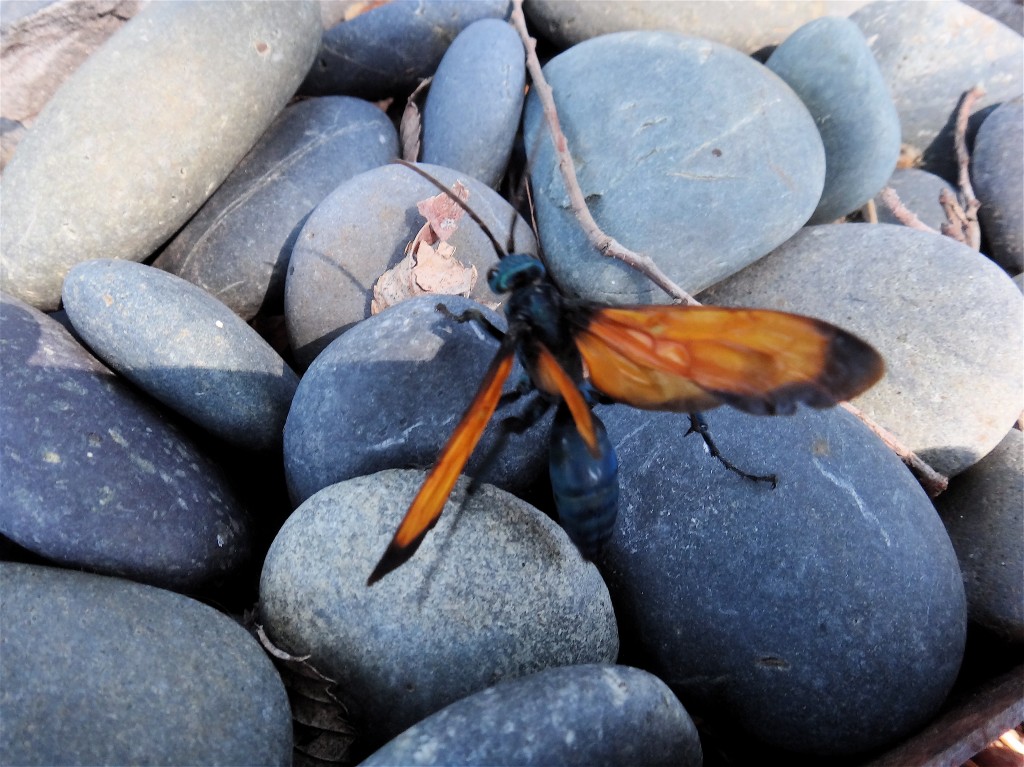 I have recently posted about daddy long legs and tarantulas, so it was timely apt to find this colorful spider wasp this week at a client’s house, its abdomen and head matching these Mexican beach pebbles almost perfectly.
I have recently posted about daddy long legs and tarantulas, so it was timely apt to find this colorful spider wasp this week at a client’s house, its abdomen and head matching these Mexican beach pebbles almost perfectly.
Genus:
Pepsis
or more commonly known as tarantula hawks or wasps.
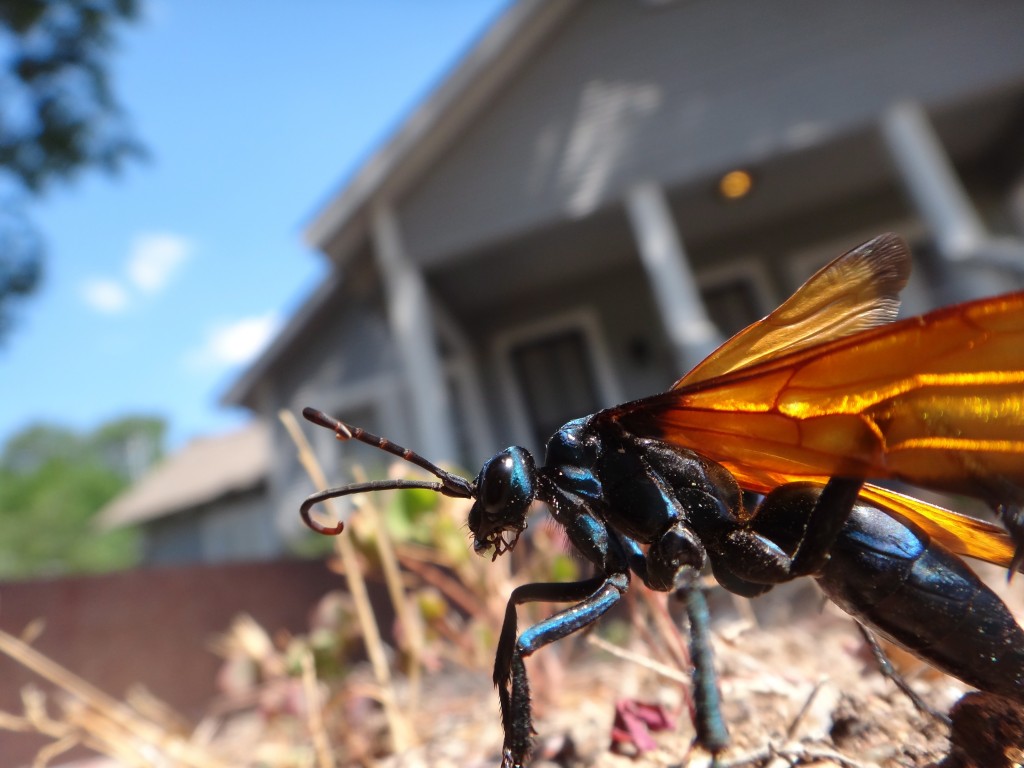 This female (curved antenna) was stunning. (do not look at the mouth part, do not look at the mouth part, do not…) I dare you to zoom in…Brrr!
This female (curved antenna) was stunning. (do not look at the mouth part, do not look at the mouth part, do not…) I dare you to zoom in…Brrr!
“Yes, yes, look at the mouth, look at the mouth, it has beautiful twitching mouth parts”.
Okay, that’s quite enough Jeff, how are the nails holding up by the way?
Females seek out tarantulas and their burrows, they then paralyze them and bury them in a burrow, laying a single egg in the spider’s abdomen. On hatching, the young larvae feed on the paralyzed spider, quite disgusting but extremely effective. These fearless wasps enter a tarantula’s burrow and may risk death in the ensuing fierce battle. The wasp usually wins even though the tarantula has poisonous fangs and is much larger than the wasp. Tarantula hawks are also more benignly seen foraging for nectar on milkweed flowers.
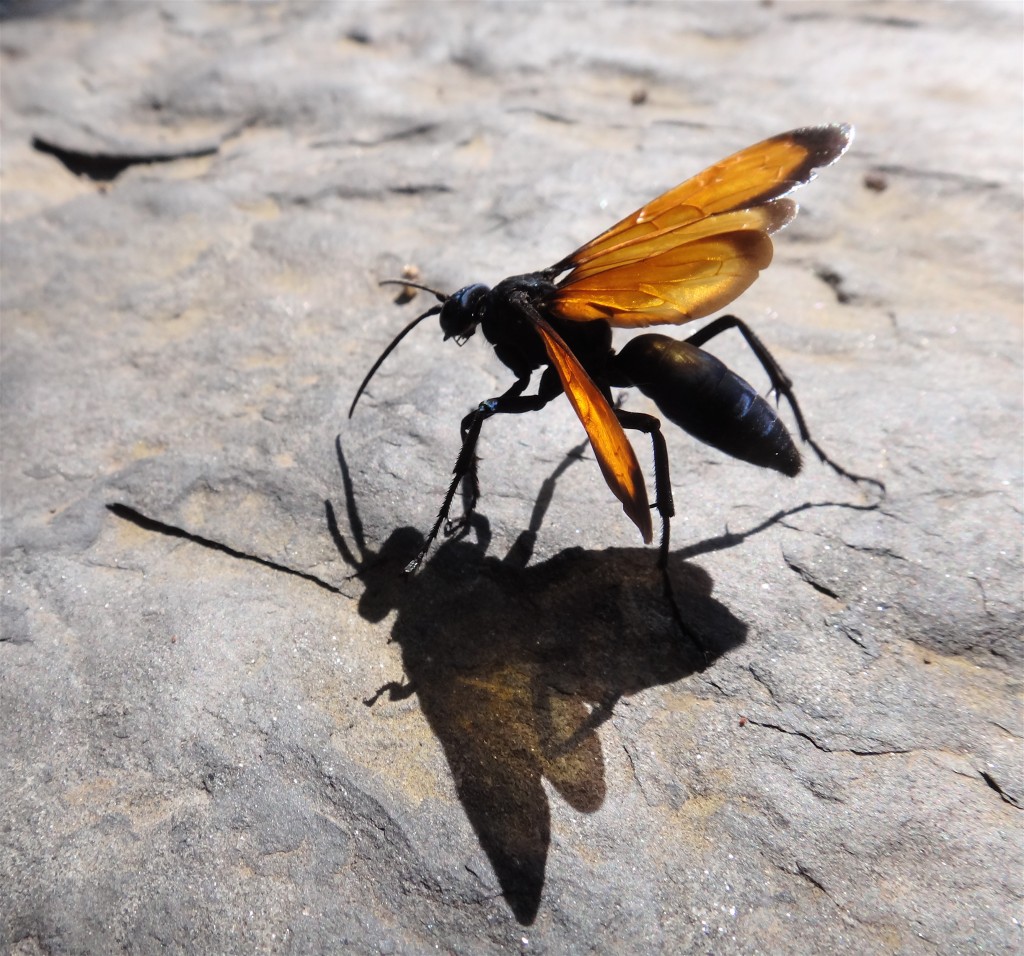 This one may have had such a battle, one of its wings clearly bent out of shape.
This one may have had such a battle, one of its wings clearly bent out of shape.
Back in the Patch:
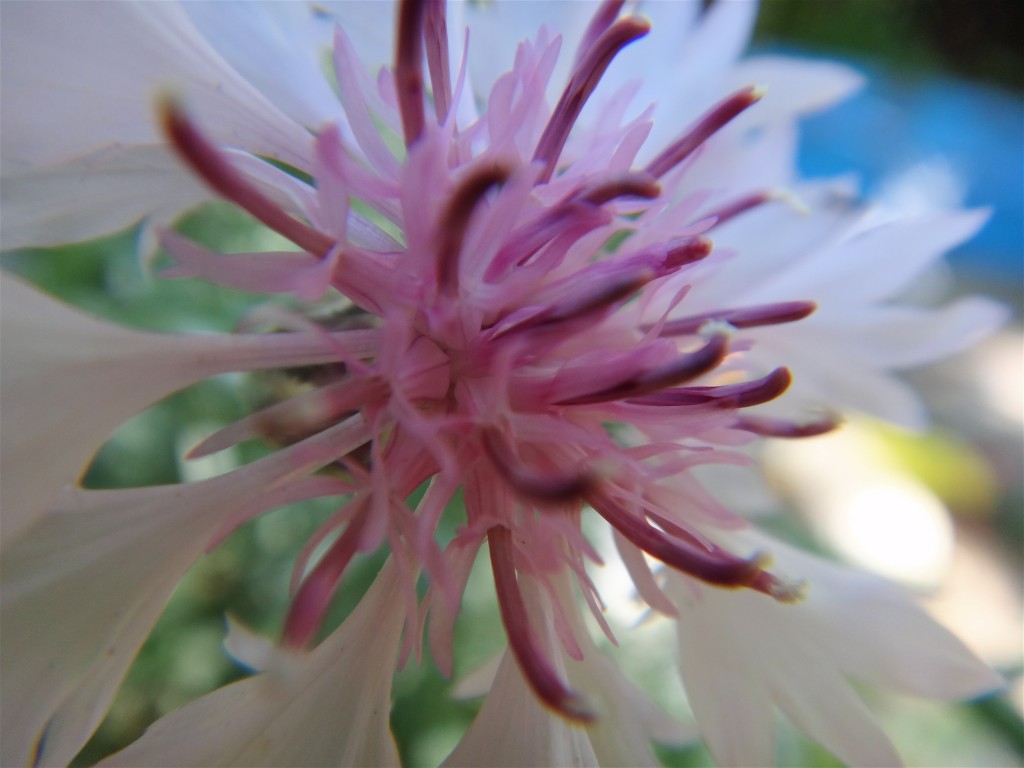 Multi-colored cornflowers are putting on a good show this year,
Multi-colored cornflowers are putting on a good show this year,
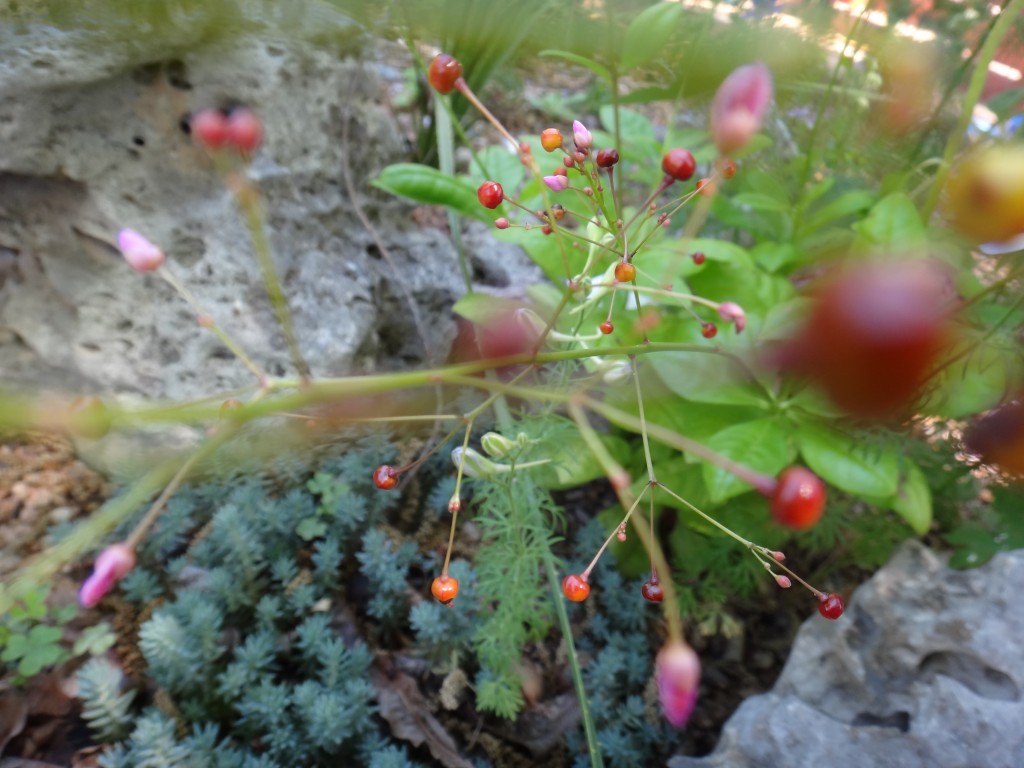 and one of my favorites, jewels of Opar is once again putting out some multi-colored precious gems.
and one of my favorites, jewels of Opar is once again putting out some multi-colored precious gems.
Talinum paniculatum
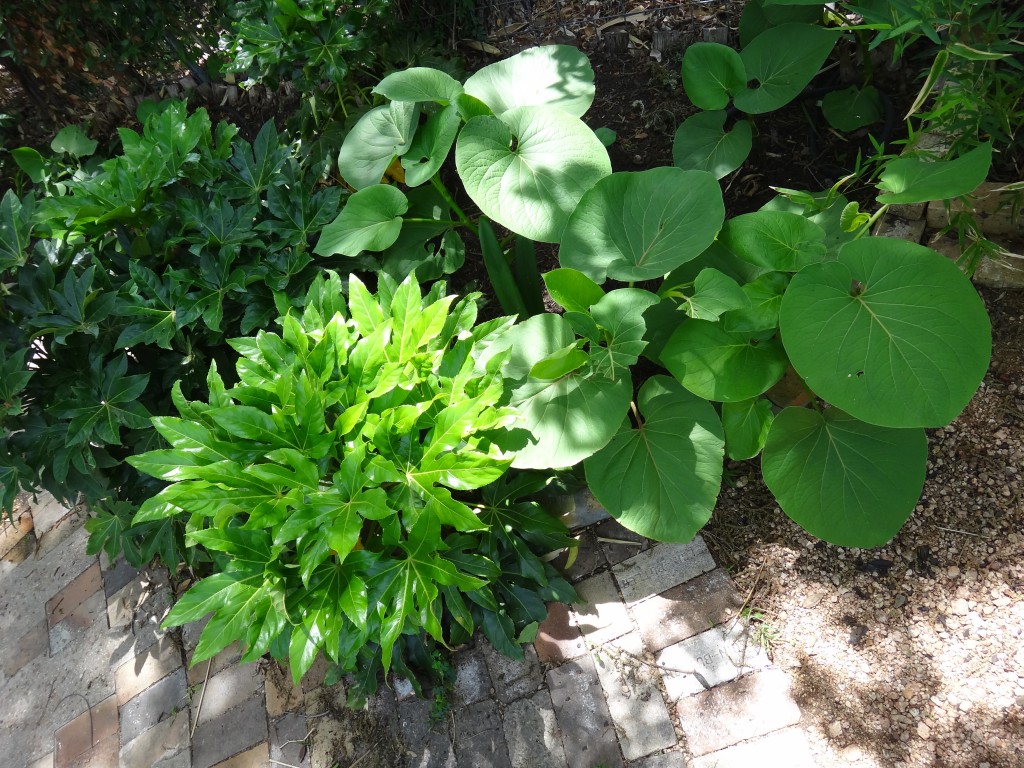 Foliage is also filling in nicely, hoja santa and fatsia Japonica make good companions with the Japonica providing winter interest and the hoja santa height in the summer months.
Foliage is also filling in nicely, hoja santa and fatsia Japonica make good companions with the Japonica providing winter interest and the hoja santa height in the summer months.
I witnessed the first dragonfly larvae and the first dragonflies this week,
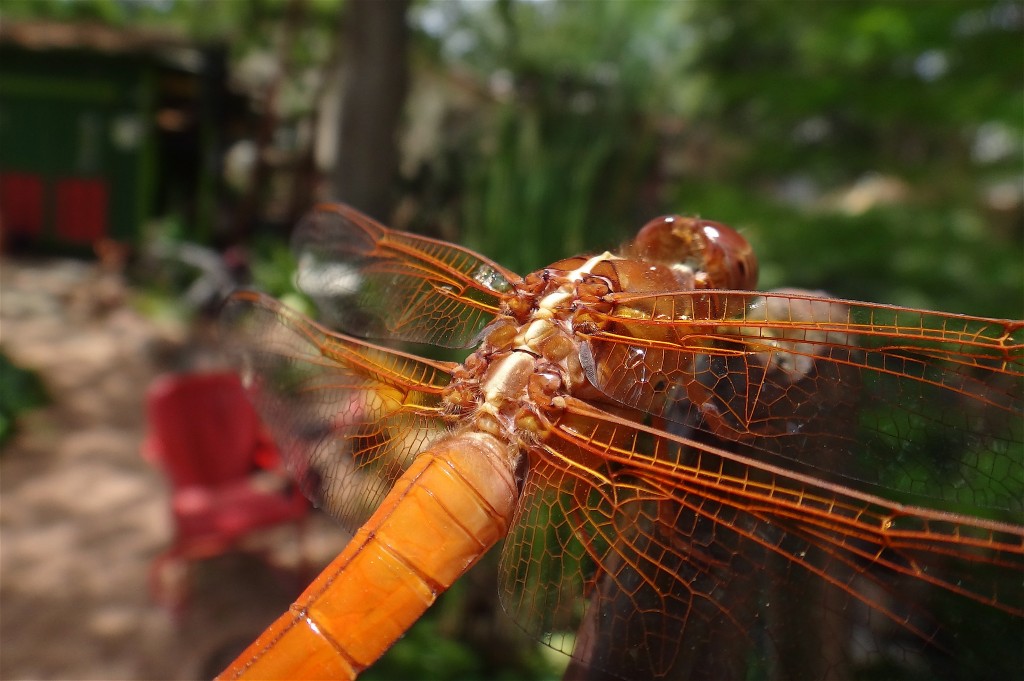 The first flame skimmer found the best perch around my main pond, and it was determined not to move and give up its position,
The first flame skimmer found the best perch around my main pond, and it was determined not to move and give up its position,
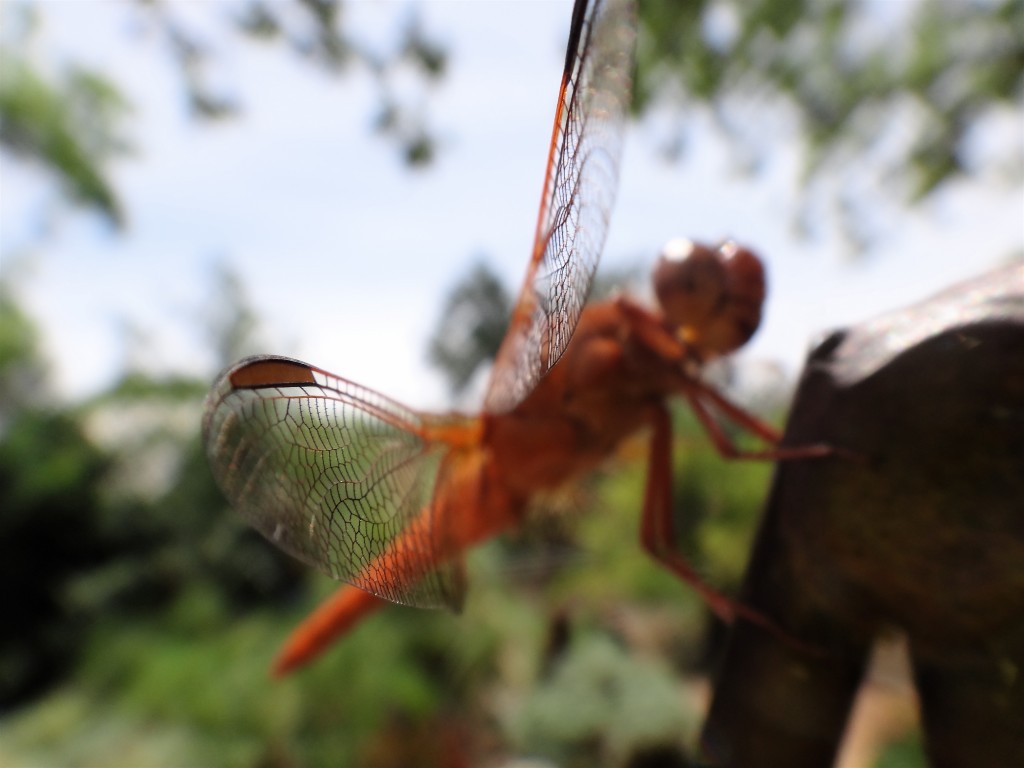 even if it meant its wing-tips brushing my camera lens. While I was quietly shooting this dragon there was suddenly a big splash on the other side of my inland sea oats, I peeped around and saw my neighbors cat once again flailing its way across my pond, the orchestra soared in, the Patch grackle hissed and danced, the cat was clambering desperately on top of my Madame Ganna Walska water lilies and generally causing total mayhem for a few seconds, a total Peter and the Wolf moment. Then all fell quiet once again.
even if it meant its wing-tips brushing my camera lens. While I was quietly shooting this dragon there was suddenly a big splash on the other side of my inland sea oats, I peeped around and saw my neighbors cat once again flailing its way across my pond, the orchestra soared in, the Patch grackle hissed and danced, the cat was clambering desperately on top of my Madame Ganna Walska water lilies and generally causing total mayhem for a few seconds, a total Peter and the Wolf moment. Then all fell quiet once again.

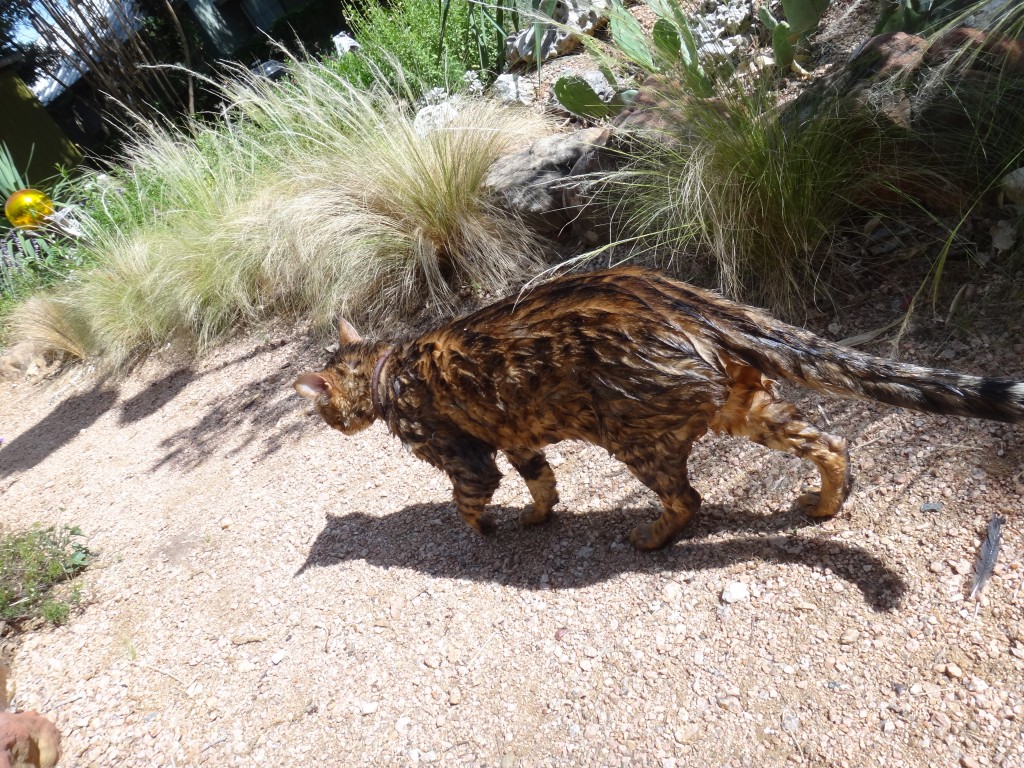 This is one embarrassed feline that never seems to learn that fishing is a dangerous sport when precariously perched on the edge of a stock tank.
This is one embarrassed feline that never seems to learn that fishing is a dangerous sport when precariously perched on the edge of a stock tank.
The pond is also entertaining tadpole hunts, she spends ages collecting and chatting to them.
 Another self initiated science project in progress in the Patch involves a large garden snail and some carrots (I knew my carrots would come in useful for something other then for human consumption, which trust me, was not an option). After we told her some time back about Gordon Ramsay preparing and eating his own snails out of his garden, she could not wait to give it a try.
Another self initiated science project in progress in the Patch involves a large garden snail and some carrots (I knew my carrots would come in useful for something other then for human consumption, which trust me, was not an option). After we told her some time back about Gordon Ramsay preparing and eating his own snails out of his garden, she could not wait to give it a try.
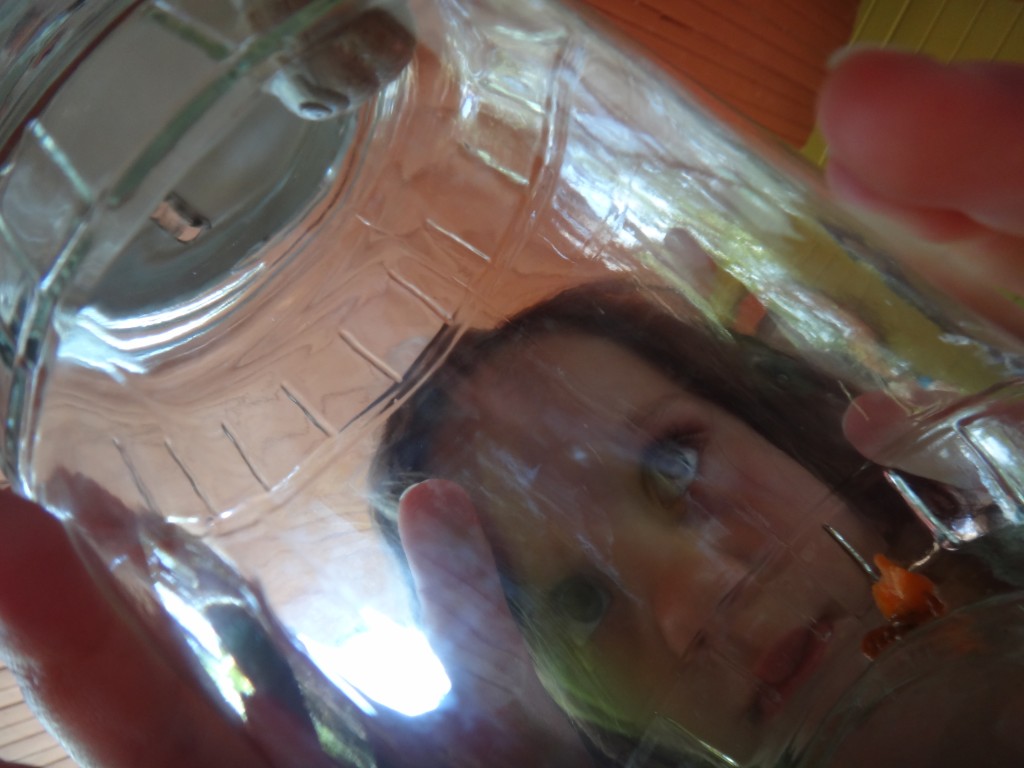 The crazy culinary artist at work.
The crazy culinary artist at work.
For the past few days she has been feeding her future ‘petite’ escargot dish with carrots to ensure that the snail was completely ahem, “cleaned out”.
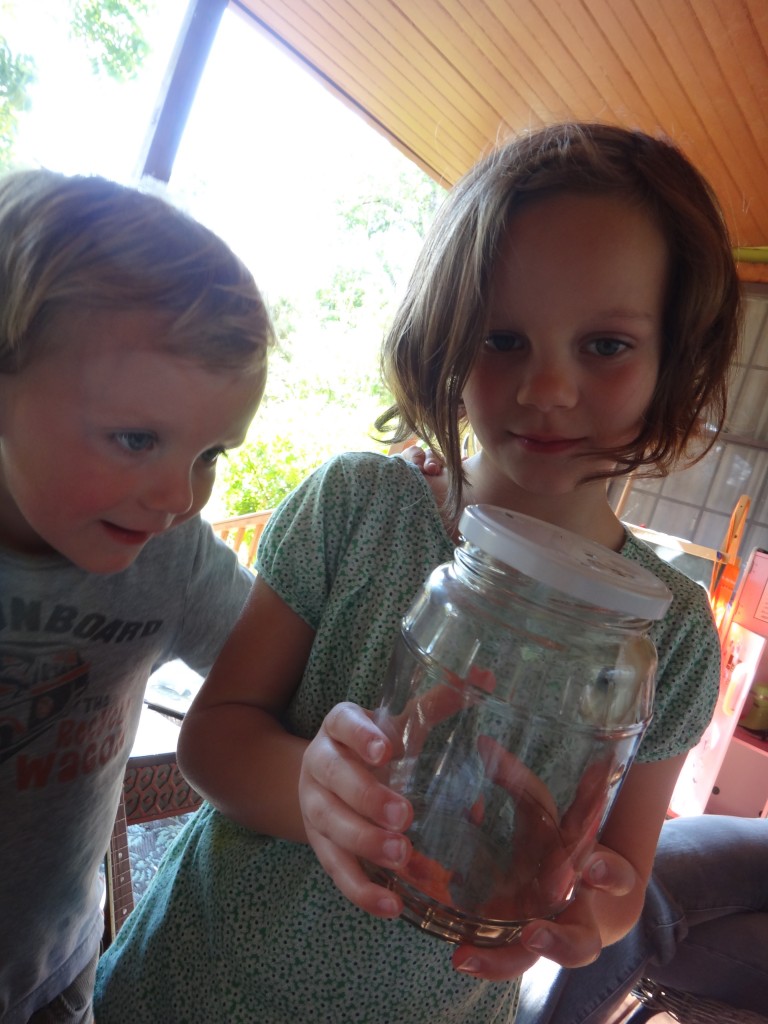 She was delighted the other day to find that the snail’s number 2s were finally an orange color, oh yes it was a momentous occasion, the church bells were ringing, a small street parade etc, it was finally ready, and so was she, she took the snail indoors and then proceeded to…more on this escargot saga next week.
She was delighted the other day to find that the snail’s number 2s were finally an orange color, oh yes it was a momentous occasion, the church bells were ringing, a small street parade etc, it was finally ready, and so was she, she took the snail indoors and then proceeded to…more on this escargot saga next week.
Installment One:
I have just completed a design and install on top of Mount Bonnell in Austin, too big to cover in one post.
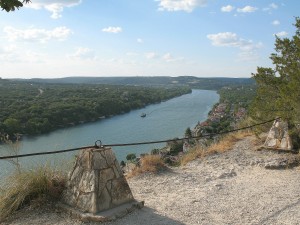 I have decided to break it up into a few installments like the Rime of the Ancient Mariner, here is the first:
I have decided to break it up into a few installments like the Rime of the Ancient Mariner, here is the first:
This was a most challenging project logistically a) it being on the top of Mount Bonnell with extremely tight access and steep grades for large trucks to circumnavigate b) below a couple inches of soil there was Mount Bonnell and an elaborate labyrinth of sprinkler pipes and low voltage lighting wires to avoid d) the design and install was on a tight schedule (just for a little added pressure!)
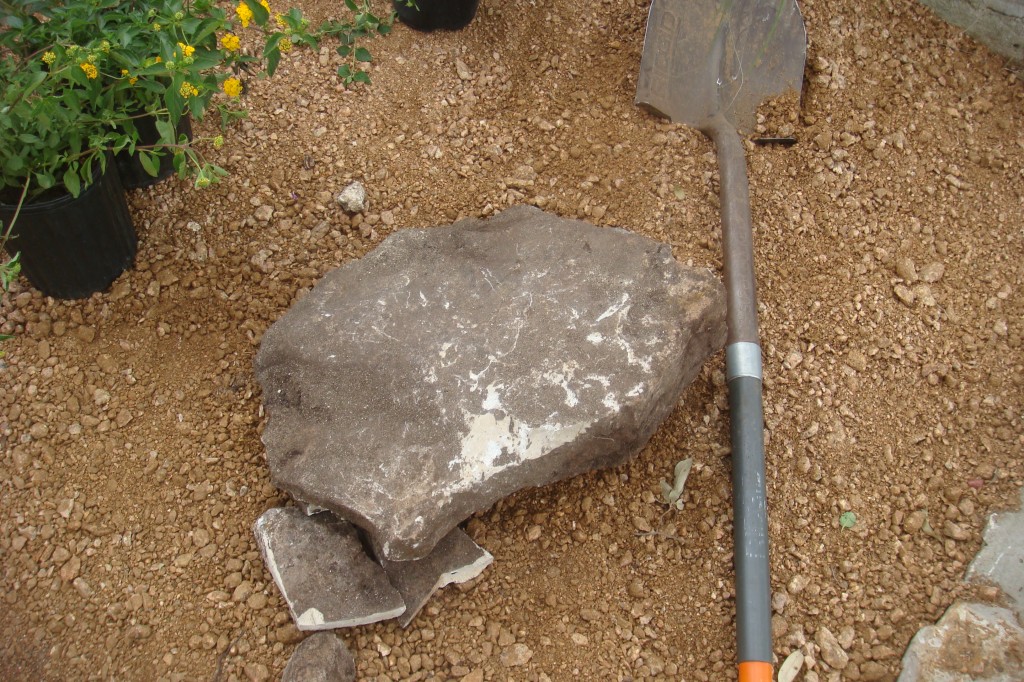 A sample of what was lurking below a thin layer of topsoil. This rock took me a half hour to extract…This one was actually deep enough that I could have planted on top of it but I decided the future night terrors would not be worth it: zzz..mumble…rock below…zzz…planted on top of it, roots sure to be stunted…(eyes fly open).
A sample of what was lurking below a thin layer of topsoil. This rock took me a half hour to extract…This one was actually deep enough that I could have planted on top of it but I decided the future night terrors would not be worth it: zzz..mumble…rock below…zzz…planted on top of it, roots sure to be stunted…(eyes fly open).
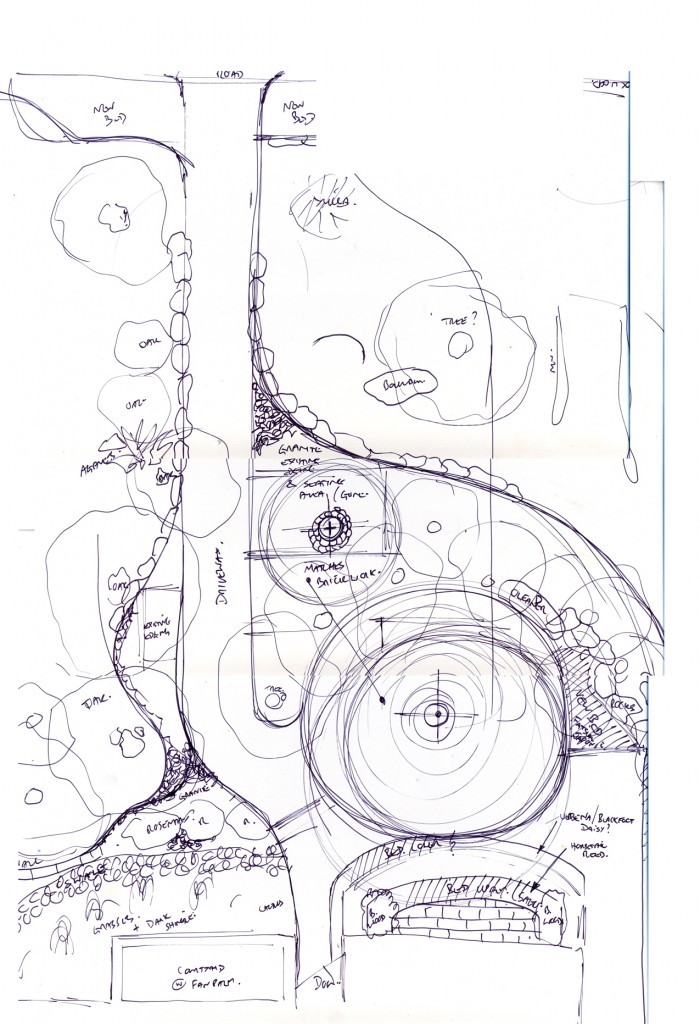
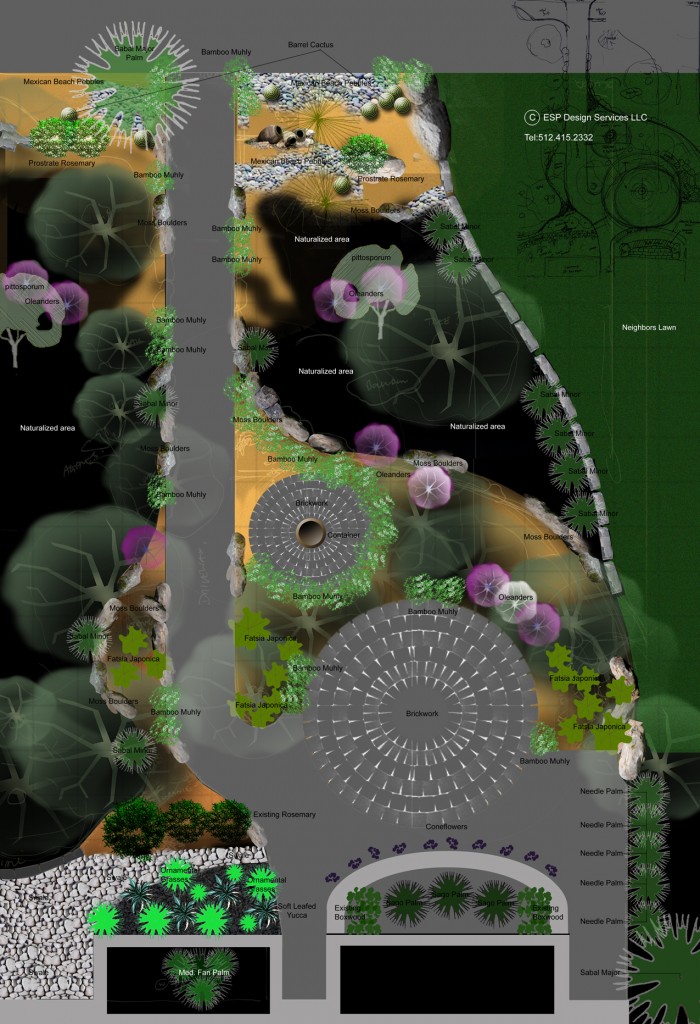 It started with a sketch, which matured into a plan highlighting the areas I was going to tackle in the allotted time frame. The major areas of focus were curbside and up around the house that had some overgrown plantings and structures that had been installed some years back and were now redundant or simply overgrown. My main intent was to provide structure and definition to these areas.
It started with a sketch, which matured into a plan highlighting the areas I was going to tackle in the allotted time frame. The major areas of focus were curbside and up around the house that had some overgrown plantings and structures that had been installed some years back and were now redundant or simply overgrown. My main intent was to provide structure and definition to these areas.
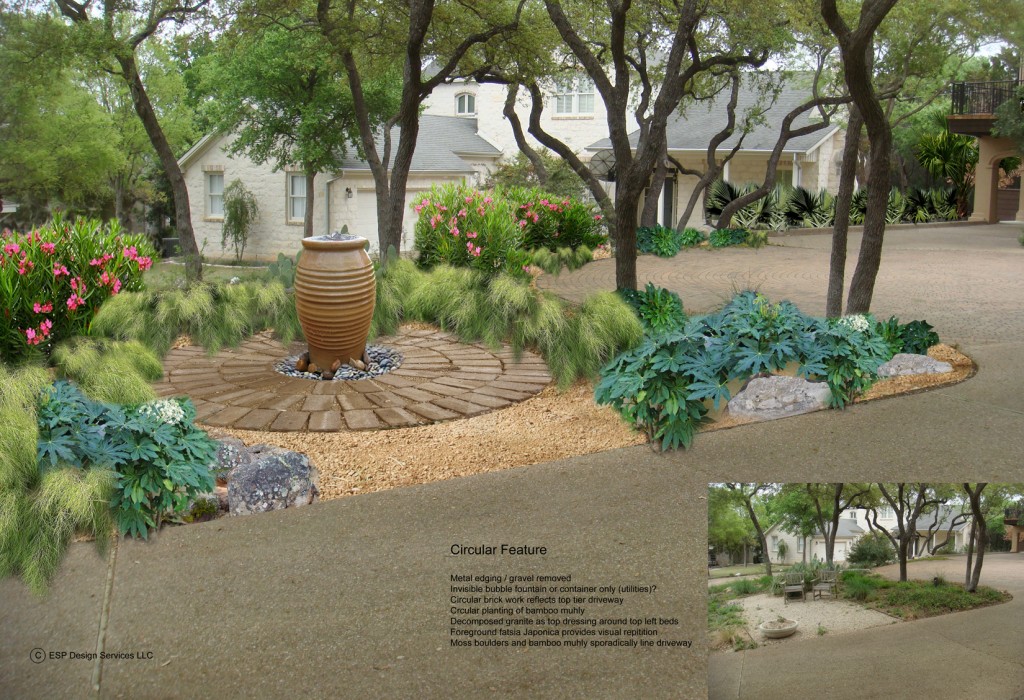 Before shot (bottom right) and rendering of one area of the proposed new design scheme. These chairs were never used by the home owners, the area was too far from the home and the seats were positioned on a downward slope of loose shingle. I found this rectangular intersection very odd with the more organic nature of the surrounding area and lines, my goal here was to naturalize the area.
Before shot (bottom right) and rendering of one area of the proposed new design scheme. These chairs were never used by the home owners, the area was too far from the home and the seats were positioned on a downward slope of loose shingle. I found this rectangular intersection very odd with the more organic nature of the surrounding area and lines, my goal here was to naturalize the area.
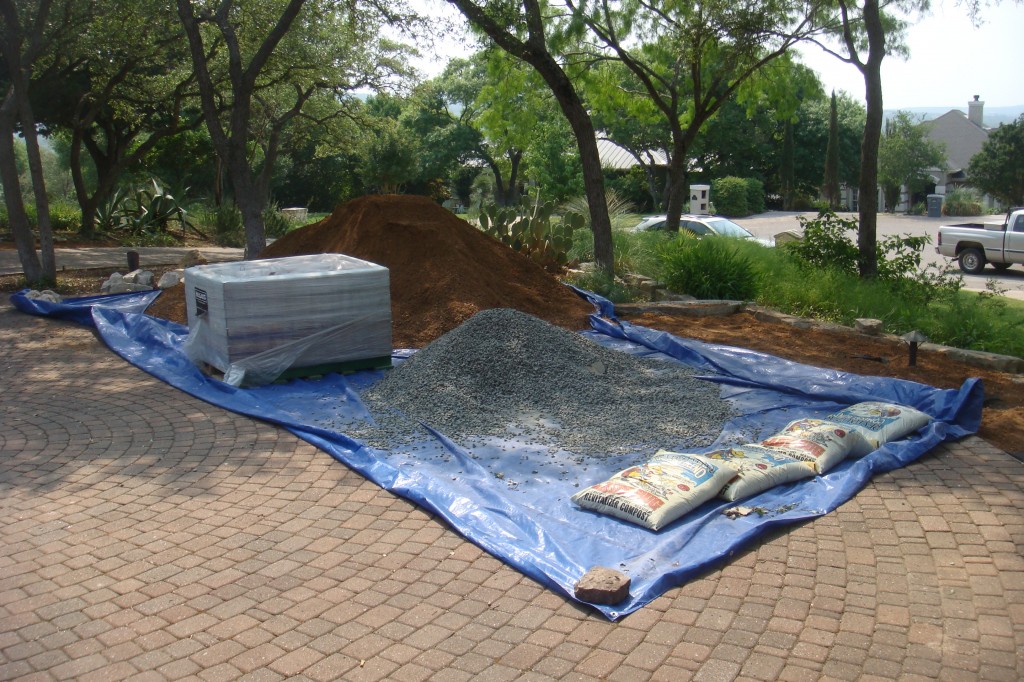
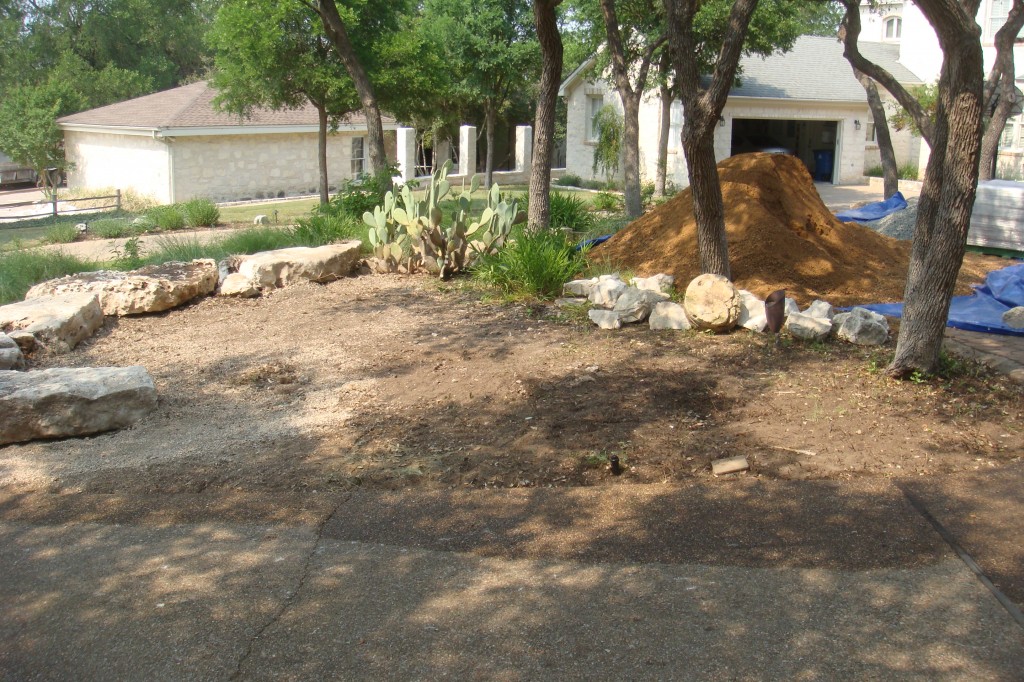 Materials were cautiously delivered with trucks narrowly missing live oak limbs by centimeters, (a most stressful time). Large limestone boulders were maneuvered into position to function as a more naturalistic retaining wall and to level the grade for the future urn. Existing metal siding was removed naturally (thanks Bob) and the area was cleared out. With the opuntia now pruned up, decomposed granite went down, deep against the boulders, swallowing out up the slope.
Materials were cautiously delivered with trucks narrowly missing live oak limbs by centimeters, (a most stressful time). Large limestone boulders were maneuvered into position to function as a more naturalistic retaining wall and to level the grade for the future urn. Existing metal siding was removed naturally (thanks Bob) and the area was cleared out. With the opuntia now pruned up, decomposed granite went down, deep against the boulders, swallowing out up the slope.
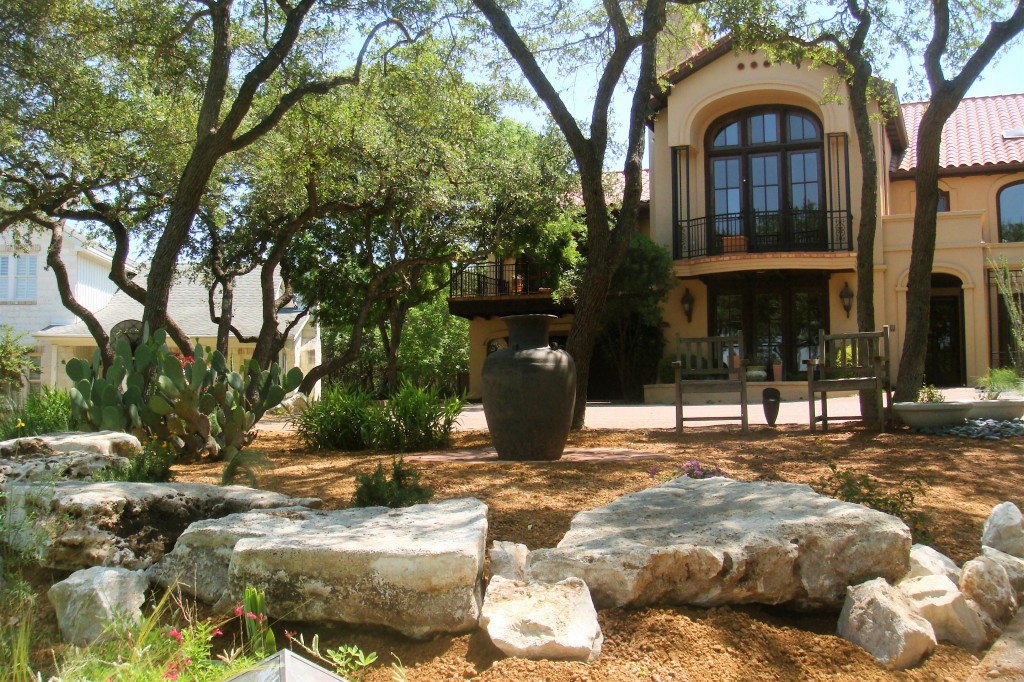
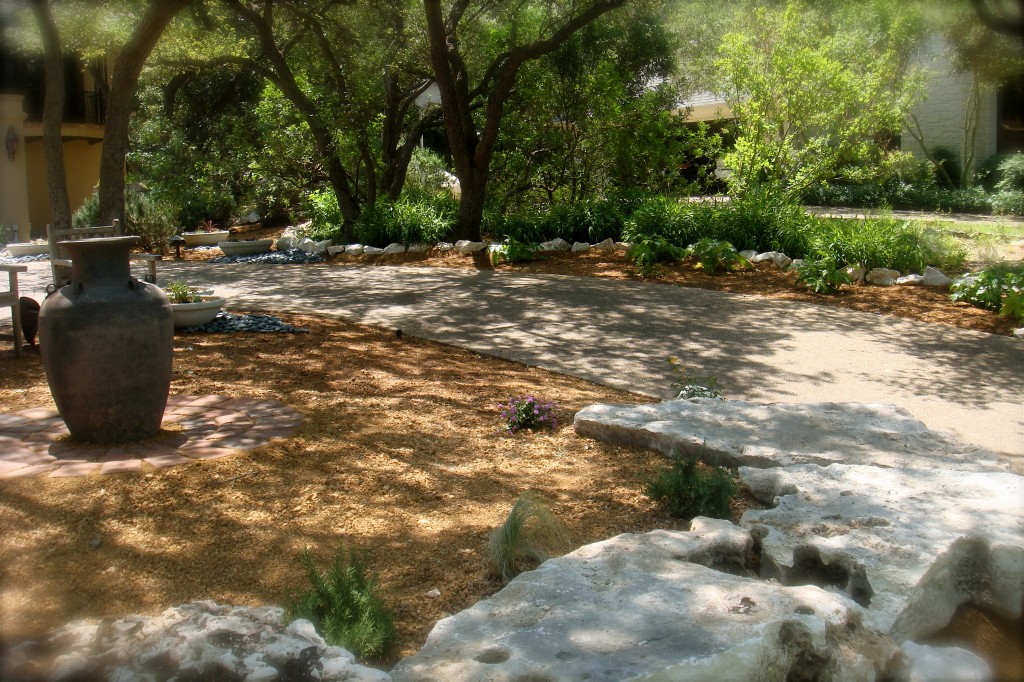 Bricks were laid, the urn was positioned and plants planted, (prostrate rosemary and trailing lantanas). The urn references the Mediterranean architectural style of the house, the color matching the dark trim. The granite will also lighten in time as it dries out, matching the house color. The large limestone boulders now join up a few side planting beds turning once separate areas into one singular sweeping bed, the rear of which I planted with a line of needle palms.
Bricks were laid, the urn was positioned and plants planted, (prostrate rosemary and trailing lantanas). The urn references the Mediterranean architectural style of the house, the color matching the dark trim. The granite will also lighten in time as it dries out, matching the house color. The large limestone boulders now join up a few side planting beds turning once separate areas into one singular sweeping bed, the rear of which I planted with a line of needle palms.
Rhapidophyllum hystrix
These palms grow very well under live oaks and will get to about 6ft quite quickly if offered some additional irrigation. They are also very rugged and cold tolerant.
Here are the before and after renderings of the other two side beds:
Stay Tuned for:
“The Emperor’s New Tools”
All material © 2011 for eastsidepatch. Unauthorized
intergalactic reproduction strictly prohibited, and
punishable by late (and extremely unpleasant)
14th century planet Earth techniques.
Captain’s Log supplemental:




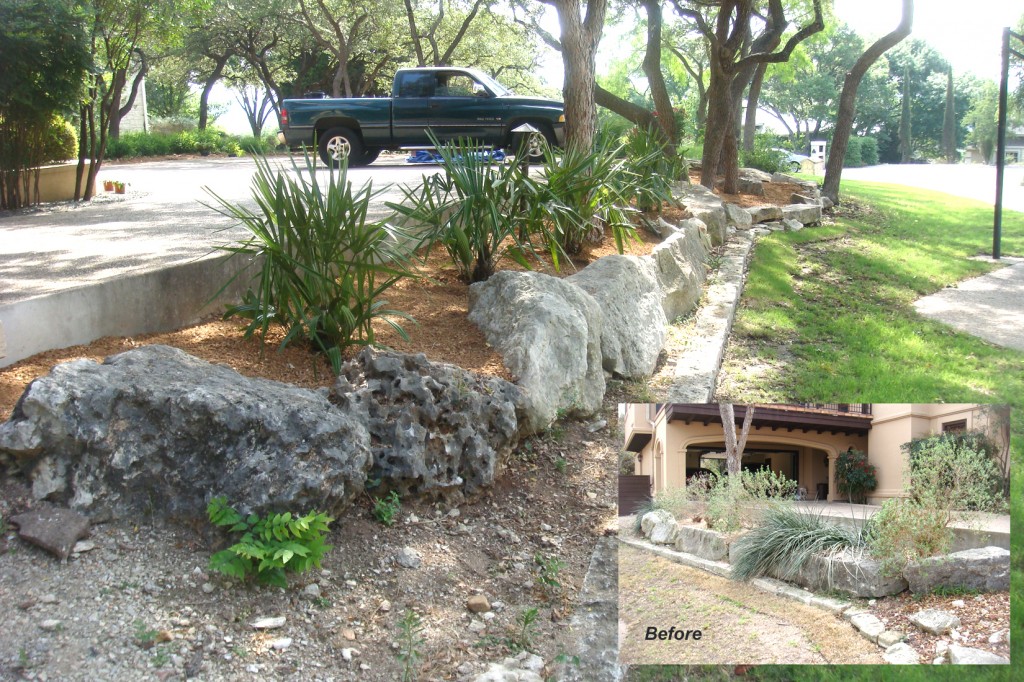
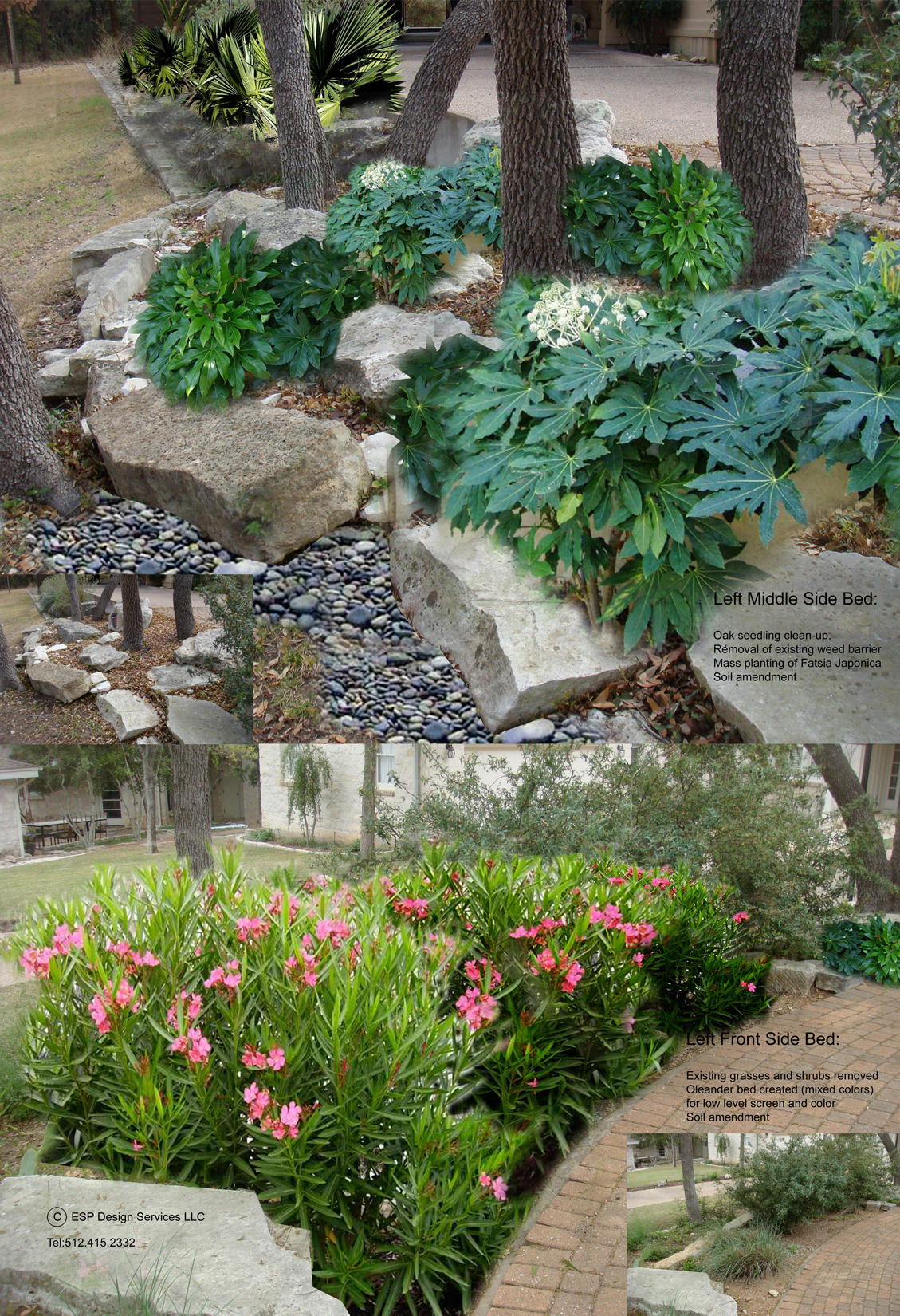
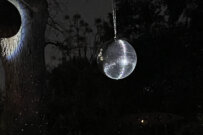





























































Comments on this entry are closed.
Well now I’m just going to have to do more with my Fatsia japonicas…more versatile than I thought!
The kids are adorable. Hope that song does not STAY in my mind….
Hi Cheryl.
One of my favorite plants for partial to deep shade, it is also very tough.
This song is nothing compared with the inchworm song which must have reverberated around my head for a month!
I will try and never do this again in a post, I promise :-)
ESP.
ESP, I love what you did for that garden, beautiful. I also love seeing your renderings with the final product, what an awesome thing. Thank you for telling me the name of that orange flying bug – I’ve had them around my pond for years, and didn’t know they were a dragonfly! How funny about the kitty falling in – mine did the same thing, but he’s a smart guy and learned after one time. But my kitty also loves water, so perhaps your neighbor’s cat doesn’t really mind getting dunked occasionally.
Hi Robin, glad you liked the garden.
The renderings really help to communicate the design intent to clients, I find that most people really struggle to interpret 2D Plan views, but when they see their own home surrounded by a new design they immediately can visualize what it is I am yammering on about. I tend to selfishly use the rendered plan views for myself, to better understand the space and to figure out the plant count, by the end of an install this sheet is usually scribbled on all over with notes, thoughts, changes etc.
The cat was so funny, they look like skinned rabbits when drenched like this, and I assure you, based on this cats expression when it clambered out, it does not care for water in the slightest.
ESP.
YeeHaws all around! Admire the ambition as well as the results of the Mt. Bonnell project. Quite lovely.
Used to be you’d see oleanders all around town, so seemingly impervious to heat and drought, yielding a bounty of tropical colored blooms all summer long. Apparently deep cold in combination with some sort of viral (fungal?) attack swept them off the table somehow years ago. I’ve missed them and they certainly are no longer one of those “ubiquitous” landscape choices many designers turn their backs on. Kudos to you for re-introducing them in this project. My Dad used to bury lower limbs from the larger specimens to start new plants – he was so fond of the banks of color they’d provide. He called them a poor man’s azalea.
YeeHaw!
Thanks TD.
I was aware of the disease when I put these plants in and decided to take the risk. I had to dig large holes for the oleanders I put in and it took quite some time and a lot of rock busting! If they do succumb to the disease replacing them will now be a breeze. The disease is called Xylella bacteria and it is vectored by a type of leafhopper. The disease is not too prominent here yet, but it is moving eastward from the Western US. I love this plant also, cannot beat it for tropical color and heat tolerance. My fingers are crossed. I will let you know if they fall victim. The Patch oleanders took a little cold beating but are rebounding fast, one is already blooming.
ESP.
Great post. Glad to see the results of the Mt. Bonnell design and implementation.
Thanks for the video…and yes I agree with Cheryl, that song is stuck in my head!! :)
Thanks Gail.
More Mount Bonnell pictures next week.
The blurry bit in the video was when N ran into my “delicate areas” with his head down like a bull…it is amazing I even held on to the camera :-)
P.
Bringing structure and definition to decline is good. Finding nice, large and full Needle Palm plants is even nicer! Thanks for sharing your process and implementation.
This is the year of the caterpillar in ABQ; seeing them on everything once I hike a little higher into less sparse grasses. It’s kinda like hiking w/ ESP at times!!
Hi David.
One of my favorite things to do, and yes the Needle Palms were in excellent condition and will fill in this strip very nicely over time.
Last year was the bumper caterpillar year for me here in Austin, never seen so many.
“Hiking w/ ESP” sounds like a tv show :-) did you ever seen the show “Fishing with John”? Brilliant.
Amazing photos and equally awesome project. Great work.
Thanks Katy.
I may have to try that needle palm if my Med fan palms continue to decline. It’s always something.
I love your semicircle of bamboo muhly around that fountain–inspired! The whole design is lovely. But how in the world do you maneuver those massive boulders, ESP?
The needle palms are really nice, they get to about 6ft tall and will fill in really well over time, I am right there with you on the Med fan palm front as you well know :-)
Thank you on the design front Pam. The boulders were “roughly” positioned using a spider, then I use rock bars and some hired hands to help muscle them and tweak them into the desired orientation. The scale of this front garden necessitated such large rocks, anything smaller would have been visually “lost” in this landscape.
ESP.
It came out great Philip. I couldn’t really see it myself when I was there. Excellent job all around. I really like small touches in a garden that make it more complete, like the little swath of dark grey gravel. A perfect small touch and I noticed it in your own garden. I think it made a big difference.
Sorry I haven’t been around. Lyn’s arm was bad but alas, it wasn’t the worst part of her fall. She had a little leg pain after wards and it has kept getting worse. Found out she has 5 bulging discs that is giving her sciatic pain down that leg. She’s being a trooper but I can tell she’s in a lot of pain. I’m having to do a lot of what she normally does around here. I didn’t realize she did so much.
Thank you Bob. And I thank you once again for helping to take out that “over-the-top” metal edging…I just hope you can make some use of it. So sorry Lyn about your fall and subsequent health ricochets, we all wish you well and a speedy recovery here in the Patch…Leah has some really great drinks that can ease a lot of pain when you are fit enough to make the journey over to the Patch again – (I swear she now dips my margarita glass in Epsom Salts). Lyn…we do not want Bob hanging out his clean dirty laundry and making dodgy cheese cakes to “aid” your recovery, any longer then necessary, do we? :-)
ESP.
I forgot to ask, she isn’t really going to eat that snail is she. Not that eating snails bothers me but I wonder about what the Naboo will think when they find out that she is into their food sources. I can only imagine that all hell is about to break loose around the Patch. I’m not coming by any time soon.
Bob…she is worrying me too with her French influences, I am English after all! She wisely harvested the large garden snails from the front garden only, (the Naboo have no influence on that terrain, as you well know). I do believe she is going to go through with the culinary experiment though, in fact, she just added four more escargots to her jar after today’s rain…it was her first priority after getting home from school. I will keep you informed on her adventurous gastronomic adventure as it develops.
ESP.
I am convinced that cats don’t like to swim because getting wet let’s everyone see how scrawny most of them are. The project looks great, will we get to see more?
Hi Les.
Cats do seem self conscious when anyone sees them in their wet suits, they are such tiny creatures beneath all that fur, it always surprises me.
Thanks on the project and yes, I will be posting more information and images in my next entry about this design and install..
ESP.